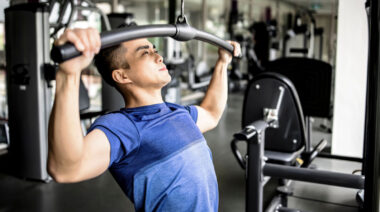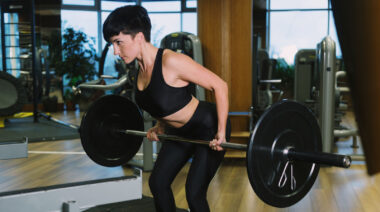Breaking Muscle author Willow Ryan wrote an article on your “wings,” specifically the development of the serratus anterior muscles. Some readers asked about how to develop this area, so let’s look into the subject a bit further.
This will be especially relevant for all you guys out there seeking a wide V-shape from the shoulders down to your waistline.
Aside from reducing body fat stores at your midsection and growing the musculature surrounding the shoulder joint, it is impossible to further develop an extremely wide shoulder-to-narrow waist ratio, sans a surgical lengthening of the scapula, clavicle, and rib skeletal-ligament structures.
That’s not going to happen. The truth is either you were born with an exceptionally wide shoulder and narrow waist configuration or you were not.
You can, however, improve upon it to an extent, so let’s take a look at how to go about it.
Whatever your shoulder-to-waist ratio, to maximize your V-shape you need to develop your shoulder joint musculature, especially the large latissimus dorsi, and work on reducing body fat stores around your waistline. Work your lats properly and eat soundly. That takes a lot of work and commitment.
Let’s look at one controllable variable of your pursuit of wider wings – developing your lats. The latissimus dorsi muscle originates all over the place:
- At the spinous processes of the lower six thoracic and all lumbar vertebrae
- At the posterior third iliac crest
- At the lumbar fascia
- At the last three or four ribs
- At the poster surface of the sacrum
- At an attachment to the inferior angle of the scapula
Moving upward, it inserts via a flat tendon that twists upon itself at the intertubercal sulcus of the humerus (upper arm) just to the front and parallel with the tendon of the pectoralis major.
Now, what exercises best address the functions of the lats? The two major gross movements are humerus extension and adduction. On a smaller scale, lats also function to medially rotate the humerus at the shoulder and depress, retract, and rotate the scapula (shoulder blade) downward.
Extension – with the arm raised straight overhead (think “touchdown”), moving it down in front past the hip and backward. These exercise do that:
- Close grip pulldowns (elbows out in front of the torso)
- Close grip chin ups
- Machine pullovers
Adduction – with the arm raised straight overhead, moving it down to the side laterally to the hip.
- Wide grip pulldowns (elbows out to the side of the torso)
- Wide grip chin ups
- The old Nautilus behind neck torso arm
For humerus medial rotation and scapula depression, retraction, and downward rotation:
- Medial rotation (rotation of the arm inward) – any medial rotating exercise or, more relevant, with a dumbbell in each hand, a lying pullover combined with upper arm medial rotation near the finish position.
- Scapula depression (downward shrug) – dip bar shrugs.
- Scapula retraction (backward shrug) – seated row shrugs.
- Scapula downward rotation – any of the aforementioned pulldown exercises address this function.
The Upper Body Squat
Understand the lats are one of the largest muscles residing in the torso. Work them hard, increase their size, and they will better contribute to weight gain and that elusive V-shape.
Similar to the barbell squat being a prime exercise for targeting the larger lower-body muscles, the now near-extinct and often-neglected pullover machine exercise was dubbed the “upper body squat” years ago by the late Arthur Jones because it targeted the large lats directly and eliminated the weak link aspect of most multi-joint exercises.
Let me explain. A multi-joint exercise involves movement around more than one joint. Examples include any pushing or pulling exercise like the bench, incline, or overhead press or seated row, bent-over row, or a pulldown on a high pulley machine. With pushes, the smaller triceps are involved. With pulls, the smaller biceps are involved.
The problem with multi-joint pushes and pulls is the smaller biceps and triceps tend to limit the potential overload on the larger muscles involved because they fatigue sooner, rendering the larger muscles incomplete of maximal overload.
Think of it as a weak link in a chain. Once the weakest link breaks, game over.
The beauty of the pullover machine is that it takes the biceps out of the equation and maximally targets the lats through a greater range of motion than a pulldown or chin up can offer.
Arthur figured this stuff out over forty years ago and it still makes sense today. Unfortunately, this valuable information has been lost in recent years due to issues beyond the scope of this discussion.
To summarize, if you want to maximize your upper body “wings,” work the latissimus dorsi muscles via pulldowns, chin ups, and especially if you can find one, a single-joint pullover machine.
And, of course, pay attention to your food intake so you minimize the fat around your waistline.






